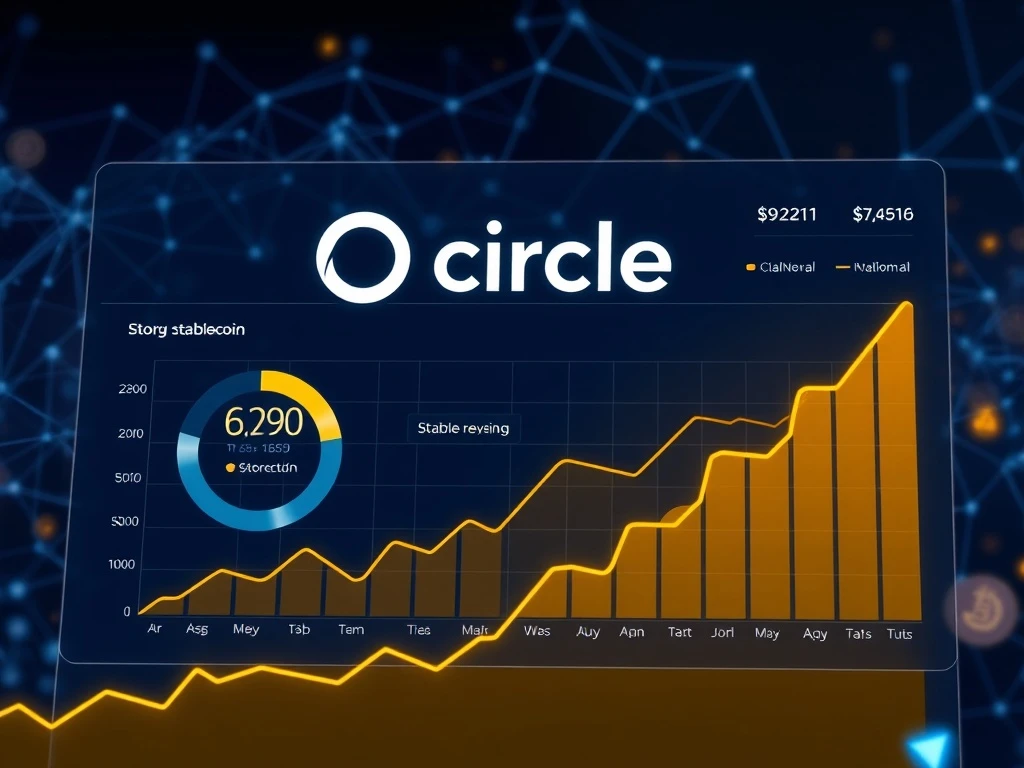The digital asset landscape constantly evolves. Presently, **stablecoin circulation** stands out as a significant trend. This surge directly impacts companies operating within the cryptocurrency space. For instance, Circle Internet Financial, a prominent player, recently announced a remarkable achievement. The company surpassed its revenue targets following a successful initial public offering (IPO). This development underscores the increasing relevance of stablecoins in the global financial ecosystem. Investors and entrepreneurs alike are keenly observing these shifts. Circle’s performance offers a compelling case study of growth in this dynamic sector.
The Soaring Tide of Stablecoin Circulation
Stablecoins represent a crucial innovation in the cryptocurrency world. These digital assets peg their value to a stable reserve asset. Typically, this asset is a fiat currency like the US dollar. Consequently, stablecoins offer price stability, unlike volatile cryptocurrencies such as Bitcoin or Ethereum. This stability makes them highly attractive for various applications. They facilitate fast, low-cost global transactions. Furthermore, they serve as a reliable bridge between traditional finance and the burgeoning decentralized finance (DeFi) ecosystem. The market for **stablecoin circulation** has expanded dramatically in recent years. This growth reflects increasing adoption across retail and institutional users. Businesses use them for international payments. Investors often hold them to preserve capital during market volatility. Therefore, their utility continues to broaden.
Circle’s Strategic Ascent and IPO Success
Circle Internet Financial stands as a major force in the stablecoin arena. The company co-founded USD Coin (USDC), one of the largest stablecoins by market capitalization. Circle’s recent IPO marked a significant milestone. It signaled strong investor confidence in the company’s business model. Moreover, the subsequent announcement of beating revenue targets further solidified this positive outlook. This financial success is not merely a corporate win. It also reflects the broader health and maturity of the digital asset market. Circle’s ability to exceed expectations highlights effective strategic planning. They successfully navigated a complex regulatory environment. This achievement positions Circle as a leader in the digital payments and blockchain technology sectors. Their strong performance consequently sets a precedent for other fintech companies.
USDC: A Cornerstone of Stablecoin Circulation Growth
USD Coin (USDC) plays a pivotal role in the expansion of **stablecoin circulation**. Circle and Coinbase launched USDC in 2018. It quickly became a dominant stablecoin. Each USDC token is fully backed by US dollar reserves. These reserves include cash and short-duration U.S. Treasury bonds. Grant Thornton, a leading accounting firm, regularly attests to these reserves. This ensures transparency and trust in USDC’s backing. USDC’s widespread adoption stems from several key features:
- Stability: Its 1:1 peg to the US dollar minimizes price fluctuations.
- Transparency: Regular attestations provide assurance regarding its backing.
- Liquidity: It is widely available across numerous exchanges and platforms.
- Utility: It supports a vast array of DeFi applications, remittances, and cross-border payments.
Consequently, the increasing demand for USDC directly contributes to the overall growth of **stablecoin circulation**. Circle earns revenue from the interest generated on the reserves backing USDC. As USDC’s market cap grows, so does Circle’s potential earnings from these reserves. This model provides a sustainable revenue stream for the company. Furthermore, it incentivizes the continued development and promotion of USDC’s ecosystem.
Driving Factors Behind Circle’s Revenue Beat
Circle’s impressive revenue performance stems from several strategic and market-driven factors. Primarily, the escalating demand for USDC played a significant role. As **stablecoin circulation** expanded, so did the pool of reserves Circle managed. This directly led to increased interest income, especially in a rising interest rate environment. Secondly, Circle diversified its revenue streams. They offer various services beyond just issuing USDC. These services include:
- Payment Solutions: Facilitating digital asset payments for businesses.
- Platform Services: Providing infrastructure for developers to build on USDC.
- Treasury Services: Helping institutions manage digital assets.
Moreover, strategic partnerships and institutional adoption bolstered their growth. Major corporations and financial institutions increasingly integrate USDC into their operations. This broadens Circle’s reach and enhances its transactional volume. The company’s focus on regulatory compliance also attracts more traditional businesses. These businesses seek secure and regulated pathways into the digital asset space. Ultimately, a combination of market growth and robust business execution drove Circle’s strong financial results.
Market Dynamics and the Future of Stablecoin Circulation
The future of **stablecoin circulation** appears promising, yet it faces evolving market dynamics. Regulatory scrutiny is intensifying globally. Jurisdictions are developing frameworks to govern stablecoins. For example, the European Union’s MiCA regulation provides comprehensive rules. The United States also continues to debate specific legislation. Clear regulations could foster greater mainstream adoption. Conversely, overly restrictive rules might stifle innovation. Competition within the stablecoin market is also heating up. New entrants and existing players constantly innovate. Central Bank Digital Currencies (CBDCs) also pose a potential long-term challenge. Governments worldwide are exploring their own digital currencies. However, stablecoins like USDC offer distinct advantages. They provide decentralized access and global interoperability. Furthermore, new use cases for stablecoins continue to emerge. These include tokenized real-world assets and advanced DeFi protocols. The ongoing innovation ensures stablecoins remain at the forefront of financial technology. Their role in a digitally connected economy will likely only grow.
Broader Implications for the Digital Economy
The rise of **stablecoin circulation** carries profound implications for the broader digital economy. Firstly, it enhances financial inclusion. Individuals in underserved regions can access digital payment systems. This bypasses traditional banking limitations. Secondly, it streamlines cross-border transactions. Businesses can send and receive payments faster and cheaper. This reduces reliance on slow, expensive legacy systems. Thirdly, stablecoins foster innovation in financial services. Developers build new applications on blockchain networks. These applications leverage the stability and efficiency of stablecoins. Consequently, the digital economy becomes more interconnected and efficient. Circle’s success further validates this transformative potential. Their financial performance demonstrates the commercial viability of stablecoin-centric businesses. Ultimately, stablecoins are reshaping how value moves across the globe. They are paving the way for a more digitized and inclusive financial future.
In conclusion, the surge in **stablecoin circulation** marks a pivotal moment in financial history. Circle Internet Financial’s impressive revenue beat underscores this trend. The company’s strategic focus on USDC, coupled with favorable market conditions, drove its success. As stablecoins gain further traction, their impact on global payments and the broader digital economy will only deepen. Circle’s journey exemplifies the significant opportunities within this rapidly expanding sector. Their strong performance provides a compelling narrative of growth and innovation in the digital asset space.
Frequently Asked Questions (FAQs)
What is stablecoin circulation?
Stablecoin circulation refers to the total number of stablecoins actively in use within the cryptocurrency market. This includes stablecoins held by individuals, institutions, and those locked in decentralized finance (DeFi) protocols. A higher circulation generally indicates increased adoption and utility of these digital assets for transactions, savings, and investments.
How does Circle Internet Financial generate revenue?
Circle primarily generates revenue from the interest earned on the reserves that back its USD Coin (USDC) stablecoin. As USDC’s circulation grows, so does the amount of reserve assets Circle manages. Additionally, the company earns revenue from various payment and platform services offered to businesses and developers who utilize USDC for their operations.
Why are stablecoins important for the digital economy?
Stablecoins are crucial for the digital economy because they bridge traditional finance and the volatile cryptocurrency market. They offer price stability, enabling more reliable transactions, remittances, and lending within the blockchain ecosystem. Their efficiency and lower costs compared to traditional banking systems also promote financial inclusion and streamline cross-border payments.
What is USDC and how is it backed?
USDC (USD Coin) is a prominent stablecoin co-founded by Circle and Coinbase. It is designed to maintain a stable value, typically pegged 1:1 with the US dollar. Each USDC token in circulation is fully backed by an equivalent amount of US dollar reserves. These reserves primarily consist of cash and short-duration U.S. Treasury bonds, which are regularly attested to by independent accounting firms to ensure transparency and trust.
What challenges does stablecoin circulation face?
Stablecoin circulation faces several challenges. Regulatory uncertainty remains a key concern, as governments worldwide work to establish clear legal frameworks. Competition from other stablecoins and the potential emergence of Central Bank Digital Currencies (CBDCs) also pose competitive pressures. Additionally, maintaining trust and transparency regarding reserve backing is crucial for continued adoption.








